| 1 | Hemprich’s coral snake |
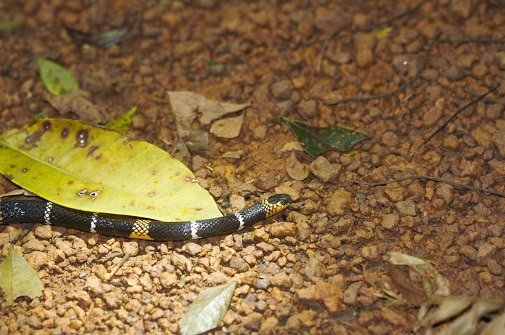
A little known, yet common species of coral snake. Micrurus hemprichii is found all over the Amazon rainforest, in central and northwestern Brazil. They also inhabit Colombia, Ecuador, and are particularly concentrated in French Guiana. This is purely a species of lowland and tropical rainforest, rarely straying to open fields, and definitely not sweeping savannah.
Males of this species are slightly longer, reaching a maximum of 86.4cm, versus 78.8cm for females. Micrurus hemprichii is a memorable coral snake for lacking any red on its body. Instead, those bands are bright orange or brownish. They always have a black face, while their neck is surrounded by a thick orange collar, like a winter scarf. This coral snake is as venomous as ever, and a 2023 study painted a mixed picture. Two cases involved only local symptoms, with no prolonged hospital stay, but one woman suffered from shortness of breath, a classic neurological symptom.
This species has one of the more unusual tendencies for a coral snake: male wrestling. Two males will coil around each other like tangled wires, and attempt to raise their head above the other. They even use a head punch, where they coil their neck up tautly, then release their head like a spring, slamming the rival snake to the ground.
| 2 | Aquatic coral snake |
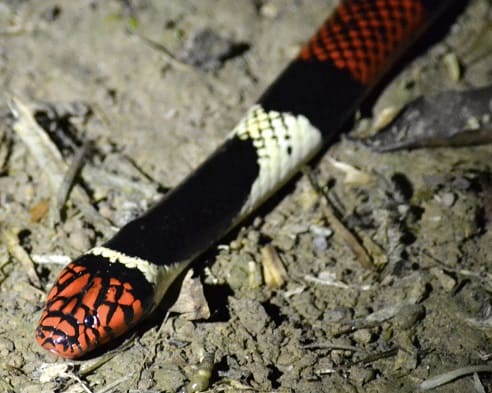
The aquatic coral snake inhabits a giant swathe of central and northwest Brazil, sticking to the Amazon region. They also inhabit Ecuador, Colombia and French Guiana, and as the name suggests, they’re far more aquatic than other species. While venturing to forest floors during the dry season, Micrurus surinamensis is more commonly found in swamps and slow-moving rivers, surrounded by humid rainforests which most sane people stay well away from.
Aquatic coral snakes are more fish-eating than most members, and one of their prey is the longtail knifefish (Sternopygus macrurus), which looks like a sharp rock wielded by a caveman. They also eat armoured catfish and marbled swamp eels, the latter also being eaten by the false water cobra, which is therefore their competitor.
Micrurus surinamensis has one of the highest venom yields of a coral snake, with 160mg injected per bite. The eastern coral snake of Florida injects just 3-5mg. Aquatic coral snakes aren’t that eager to bite, as they normally hide their head in coils first, flatten their body and wiggle their bright tail as a decoy. However, they’ll bite if they feel all other options are exhausted.
Micrurus surinamensis is strongly nocturnal, and one decent ID sign is their face. The aquatic coral snake has a red face adorned with black markings, unlike Hemprich’s coral snake (black) or the Brazilian short-tailed (white with black). This coral snake hardly ever climbs trees, but juveniles have been spotted on vines 1.35 metres above ground. Within the coralsnake family, the aquatic coral snake’s closest relatives are the ribbon coral snake (Micrurus lemniscatus), followed by Hemprich’s coral snake.
| 3 | Caatinga coral snake |
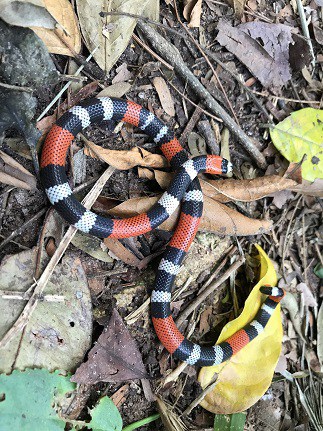
This coral snake holds the honour of being the easternmost in the world, at least in the 82 member Micrurus family. Caatinga coral snakes are abundant in eastern Brazil, including near Recife and Salvador. Brazil is the only country they inhabit, but they inhabit a large area of the Atlantic coast. There they largely stick to forests, including deciduous and Araucaria moist forests, and occasionally agricultural fields.
This coral snake reaches a maximum of 147cm. Its venom appears to be powerful, as a case from northeast Brazil in 2017 shows. A 60 year old man was bitten while tying up his cattle, after reaching into a thick clump of grass. The symptoms began with muscle paralysis and sweating, after which he was admitted to intensive care and given 10 vials of antivenom. The next wave of symptoms included headache, chest pain, and a severely painful arm. Other neurological symptoms like visual disturbances and respiratory distress were lacking. The man ultimately survived with no lasting effects, probably because he received antivenom 75 minutes after being bitten.
Micrurus ibiboboca preys largely on fellow snakes, a diet which sometimes goes wrong, as one was observed to have died after attempting to swallow a large cat-eyed night snake. Other meals include amphisbeanas, amphibians with an elongated body.
| 4 | Amazon coral snake |
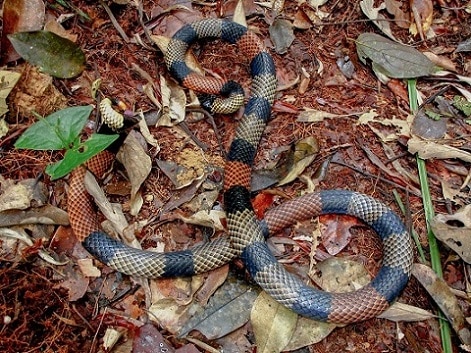
A large coral snake reaching a maximum of 160cm, which mainly inhabits central and northwest Brazil. This holds a weird record, as it probably has the fewest sightings in proportion to its vast territory. As this iNaturalist map shows, it covers the whole Amazon region from west to east, yet there’s no more than a handful of dots for sightings.
Micrurus spixii is also called the Peruvian coral snake, and many natives consider it to be the most dangerous snake nearby. It has a different venom to most coral snakes. While still possessing the usual neurotoxins which shut down brain transmissions to muscle and lungs, its venom also has strong haemorrhagic and procoagulant properties. In a 2015 study, the venom caused severe swelling of mice legs, and a rise in creatine kinase, which is a widely used indicator of muscle tissue destruction, meaning that this venom is myotoxic (muscle-targeting).
Micrurus spixii mainly sticks to lowland rainforests. They have the following patterns: wider red bands, followed by black-white-black-white-black bands. Most of their face is black and white, but the corners of their mouths have a subtle red patch. Amazon coral snakes are closely related to the Brazilian short-tailed coral snake (Micrurus brasiliensis).
| 5 | Uruguayan coral snake |
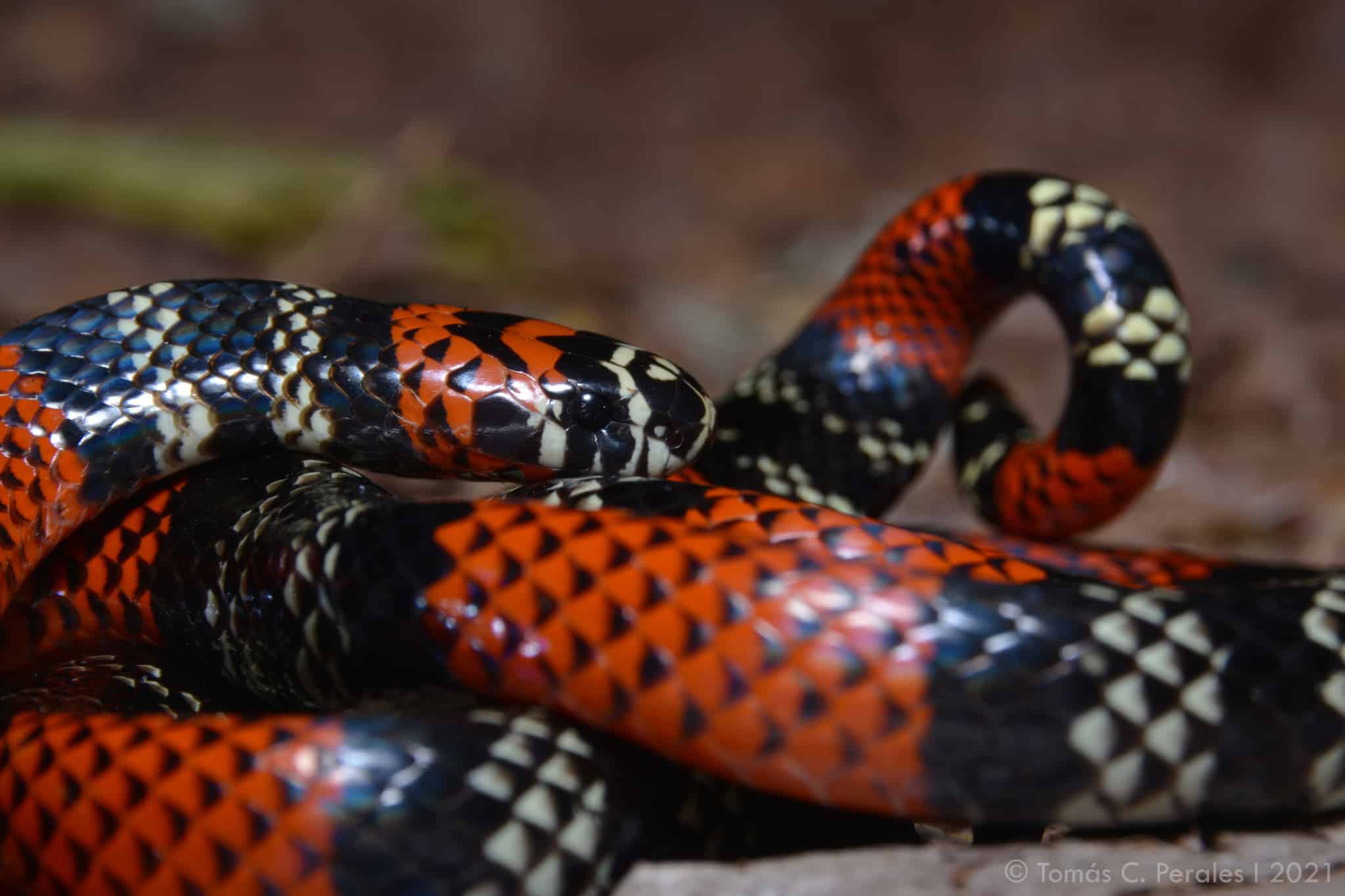
A coral snake found not only in Uruguay, but far southern Brazil, eastern Paraguay, and northeast Argentina. Micrurus altirostris is a species of humid forests, including the Atlantic forests of Brazil, and humid riparian forests following the course of the Uruguay river. They mainly feed on fellow reptiles, including snakes such as Brongersma’s worm snake and pale-headed blind snakes.
This is a dangerous coral snake, which is underestimated at your peril. Studies reveal a host of powerful post-synaptic neurotoxins, which bind to and block acetylcholine receptors in muscle cells, preventing brain signals from being transmitted. This is a similar mechanism to the black mamba thousands of miles away. Most worryingly, commercial coral snake antivenom has limited effect on Micrurus altirostris.
This species typically measures 80cm. Uruguayan coral snakes have striking patterns, with traditional black, red and white, and a constant static of black patterns overlaying the red. Rather than clean black (like Hemprich‘s coral snake), its face is a messy mixture of black and white, making it hard to spot its eyes amidst the chaos.
| 6 | Brazilian short-tail coral snake |
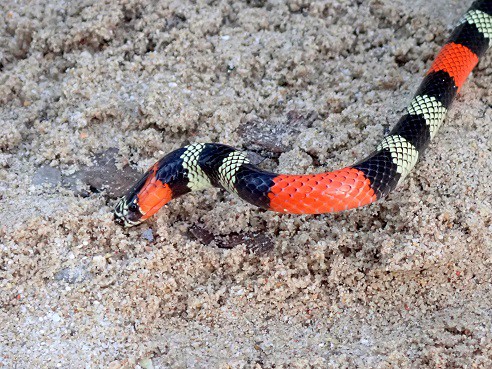
This species was originally assigned as a southern coral snake (Micrurus frontalis) subspecies, until being granted full species rights in 1999. Brazilian short-tail coral snakes (Micrurus brasiliensis) average at 65cm and are a triad species with typical coral snake colours, in the following pattern: red, black, white, black, white, black, red.
This species lives solely in eastern Brazil, including Bahia and Minas Gerais states. It’s far less common than the Hemprich’s coral snake and is considered endangered. Rather than rainforest, they mainly favour dry rocky grassland and sandy dry forests, habitat which is being destroyed to make way for profitable soybean and sugar plantations. They’re also threatened by the construction of hydroelectric plants. This species is contained solely within Brazil, with no spillage into Paraguay or Uruguay.
Being a new species, Micrurus brasiliensis is poorly researched compared to other Brazilian coral snakes. However, they’re confirmed to feed on fellow snakes, including Reinhardt’s burrowing snake (Apostolepis assimilis). This snake has a pale face with black markings, and the pale bands vary from white to yellow.
| 7 | Black-necked Amazonian coralsnake |
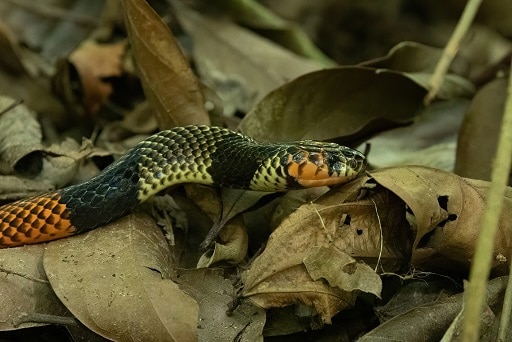
A species of extreme western Brazil, mainly in Acre state. Micrurus obscurus also inhabits Peru, eastern Ecuador and southern Colombia, following a line east of the Andes. They’re mainly a rainforest dweller, including pristine and heavily disturbed rainforests. However, they also stray to adjacent agricultural land, forest clearings, and villages near forests. Micrurus obscurus sometimes takes shelter under leaf cutter ant nests or in logs.
This one of the more striking coral snakes. While they possess the usual red, yellow and black colours, everything is constantly intermingling, particularly on the face, which is creamy with smudges of red and a bright red jaw. Also, the yellow sections are much creamier-looking than other coral snakes.
This is a relatively long coral snake. In January 2012, a new record was set when a dead Amazonian black-necked coral snake was found on a forest road near agricultural fields. It measured 155.5cm, which well exceeded a previous record of 134.5cm. This was also one of the longest Micrurus coral snakes found to date.
This coral snake has neurotoxic, myotoxic and haemorrhagic venom. However, the yield is only 10-35mg per bite, and the venom is less lethal than other Amazonian coral snakes. Its venom also varies between individuals, possibly growing simpler with age. As well as biting, a disturbed Micrurus obscurus will thrash its body for up to 3 seconds.
This species is somewhat controversial. Their closest relative is the Amazon coral snake, Micrurus spixii, and some consider them to be a mere subspecies. However, this 2019 study found that Micrurus obscurus has significantly shorter venom-inoculating fangs than its cousin.
| 8 | Decorated coral snake |
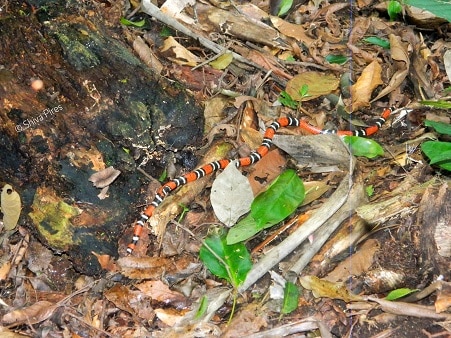
A relatively mysterious coral snake. The decorated coral snake (Micrurus decoratus) inhabits a small section of southeast Brazil along the Atlantic coast, including near Rio de Janeiro. They inhabit Atlantic forests, but only at altitudes above 700 metres, and up to at least 1500 metres.
This is one of the smaller coral snake species. In a 2002 study covering 55 decorated coral snakes, the longest male measured 64.5cm, while the longest female reached 57.0cm. The study also identified 5 prey in their stomachs. Three were caecilians (elongated amphibians), while two were amphisbaenians (elongated reptiles). One specific prey is Hardy’s caecilian. Decorated coral snakes seem to prey on fellow snakes less, perhaps because of their shorter length.
Decorated coral snakes have a strong tendency to raise their tail in the air when threatened, showing the bright colours. The study above found that they raised their tail without fail when frightened, even when touched gently. They also flatten their bodies to create a deceptive impression of size.
This species overlaps with the painted coral snake (Micrurus corallinus) in its entire territory in southeastern Brazil. The latter is far more common, and is easy to separate, as they have one black band sandwiched between two thin white ones (pic), followed by a large red spacing. Meanwhile, the decorated coral snake has 3 black bands, with a white inbetween each (again followed by a swathe of red).
| 9 | Paraíba coral snake |
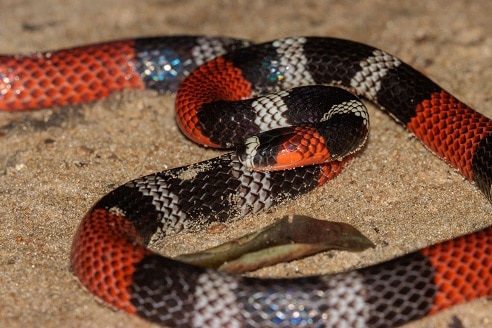
A new coral snake species, identified only in 2014. Micrurus potyguara is found solely in lowland coastal forests, and lives exclusively in northeast Brazil. This species may be endangered, surviving in pockets of trees amid agricultural fields and grassland.
The new species was easily confusable for a layman, but possessed a series of characteristics not combined in any other coral snake. These included a head slightly broader than the neck, an entirely black snout tip, with a white ring around the snout before the eyes, then the rest of the head being black.
The first black band after the neck was far longer than its neighbours, like the Caatinga coral snake (which it overlaps with). Caatinga coral snakes also had thicker white bands on the body, and a smaller number of ventral (belly) scales.
Paraíba coral snakes have a standard triad pattern: wide red bands, followed by black-white-black-white-black. As of 2023, its venom and diet are still unresearched. Meanwhile, the Latin name of Micrurus potyguara references the native Tupi people who once lived in northeast Brazil, who fished for shrimp for their economic survival.
| 10 | Annellated coral snake |
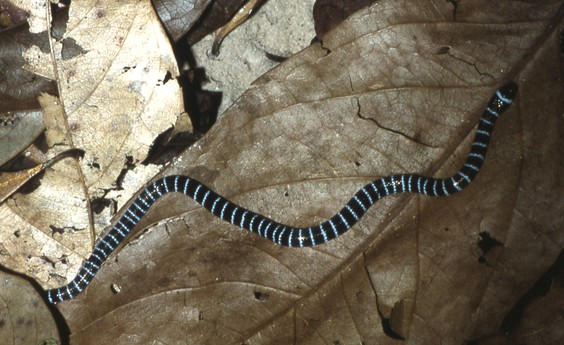
This coral snake mainly inhabits Peru, but also far western Brazil, as well as eastern Ecuador (east of the Andes). Micrurus annellatus is a relatively short species (30-80cm), which is commonly found resting on leaf litter beds in rainforests, plotting their next move. They can also be found in cloud forests at up to 2000 metres in altitude.
Venom research is very scarce, but a few reports have trickled in. A 47 year old man was bitten in western Brazil, and experienced uncoagulable blood for 3 days, with clotting factors completely disabled. Luckily, he didn’t experience any medically significantly bleeding, and was discharged from hospital in fine health.
Annellated coral snakes have 3 subspecies, with two inhabiting Brazil. Micrurus annellatus annellatus has just two colours on its body (see above), with rapidly alternating black and white, and occasionally black and red. M. annellatus bolivanus is more common in Brazil, and features the usual 3 colours, in the order of red, white, black, white, red. However, the red bands are by far the widest, and the white bands are severely thin (see this image). This species is one of the more poorly researched coral snakes overall.
